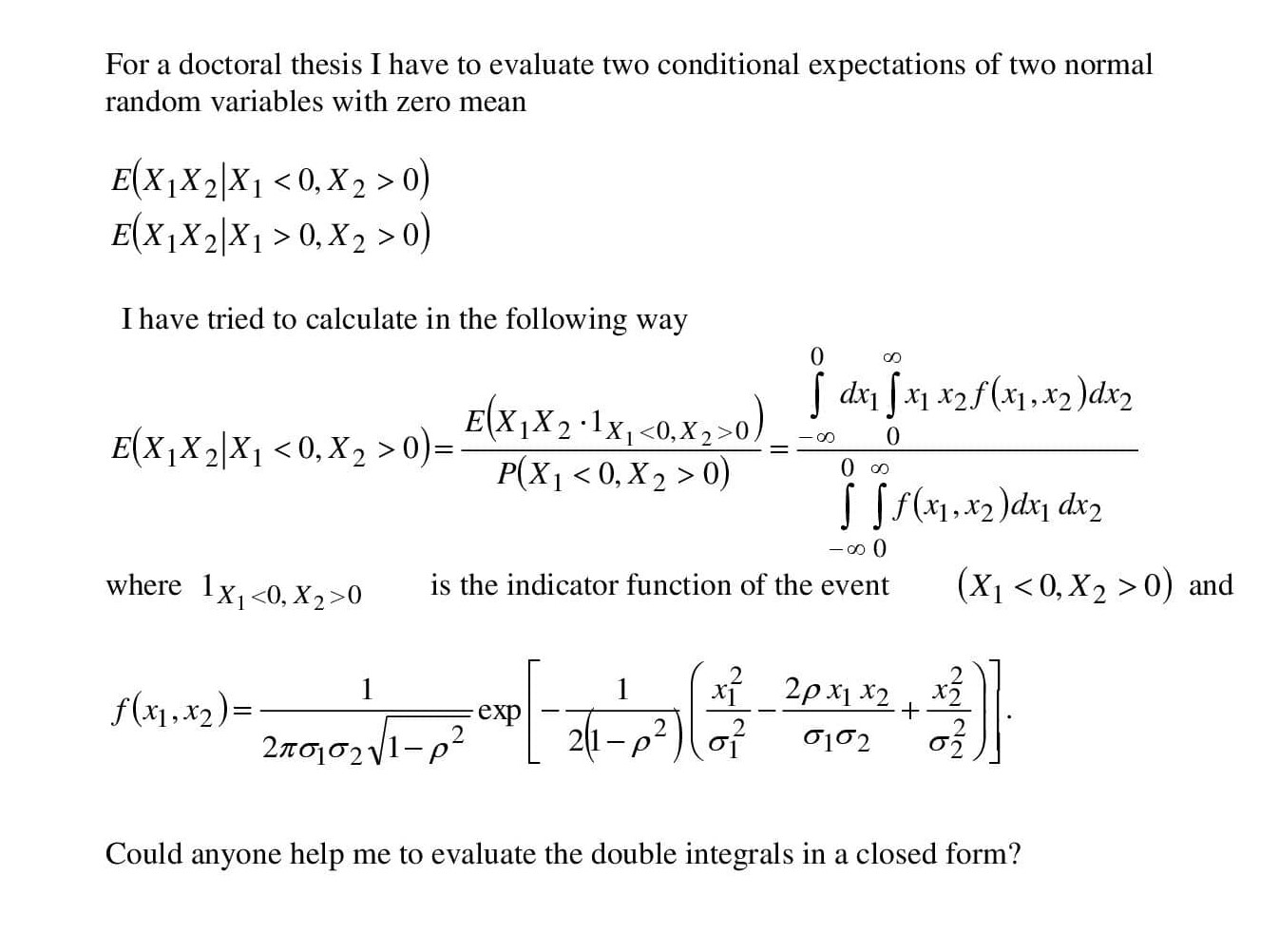The evaluation of the moments of doubly truncated bivariate normal distribution leads to the formulas with a great complexity. It has not been possible to derive explicit formulae for the moments except some particular cases.
1 Answer
To be explicit, write $f(x_1,x_2,\rho,\sigma_1,\sigma_2)$ for the bivariate normal density.
From the analysis at https://stats.stackexchange.com/a/71303/919 it is clear that the normalizing integral is the angle (as a fraction of the full circle) subtended by the quadrant in question when the ellipse is transformed back to the unit circle; in particular,
$$F(\rho,\sigma_1,\sigma_2) = \iint_{x_1\gt 0,\, x_2\gt 0} f(x_1,x_2,\rho,\sigma_1,\sigma_2)\,\mathrm dx_1\mathrm dx_2 = \frac{1}{\pi} \arctan\left(\sqrt{\frac{1+\rho}{1-\rho}}\right).$$
(Notice this does not depend on the $\sigma_i.$)
Our immediate goal is to exploit this result to compute
$$G(\rho,\sigma_1,\sigma_2) = \iint_{x_1\gt 0,\, x_2\gt 0} x_1x_2 f(x_1,x_2,\rho,\sigma_1,\sigma_2)\,\mathrm dx_1\mathrm dx_2$$
for $-1 \lt \rho \lt 1$ and $\sigma_i\gt 0.$ We will eventually make use of the fact that the $\sigma_i$ are scale parameters, which implies
$$G(\rho,\sigma_1,\sigma_2) = \sigma_1\sigma_2 G(\rho, 1, 1)$$
for all positive $\sigma_i.$
Write
$$\rho^\prime = (1-\rho^2)^{-1/2}.$$
Setting $\sigma_i = \rho^\prime$ makes $F$ particularly simple:
$$F(\rho,\rho^\prime,\rho^\prime) = \frac{1}{2\pi\rho^\prime} \iint_{x_1\gt 0,\, x_2\gt 0}\exp\left[-\frac{1}{2}\left(x_1^2 - 2\rho x_1 x_2 + x_2^2\right)\right]\,\mathrm dx_1\mathrm dx_2.$$
Because the integrand is rapidly decaying and smooth, we may differentiate the integral with respect to $\rho$ by differentiating its integrand:
$$\begin{aligned} \frac{\mathrm d}{\mathrm d \rho}(\rho^\prime F(\rho,\rho^\prime,\rho^\prime)) &= \iint_{x_1\gt 0,\, x_2\gt 0}\frac{\mathrm d}{\mathrm d \rho}\exp\left[-\frac{1}{2}\left(x_1^2 - 2\rho x_1 x_2 + x_2^2\right)\right]\,\mathrm dx_1\mathrm dx_2 \\ &= -G(\rho,\rho^\prime,\rho^\prime). \end{aligned}$$
Computing the derivative (bearing in mind that $\rho^\prime$ is a function of $\rho$) yields
$$\begin{aligned} G(\rho,\sigma_1,\sigma_2) &= \frac{\sigma_1\sigma_2}{(\rho^\prime)^2} G(\rho,\rho^\prime,\rho^\prime)\\ &=\frac{\sigma_1\sigma_2}{2\pi}\left(1 + \frac{2\rho}{\sqrt{1-\rho^2}} \arctan\left(\sqrt{\frac{1+\rho}{1-\rho}}\right)\right). \end{aligned}$$
The value of your second expectation therefore is
$$E[X_1X_2\mid X_1\gt 0,\ X_2\gt 0] = \frac{G(\rho,\sigma_1,\sigma_2)}{F(\rho,\sigma_1,\sigma_2)}.$$
Because $(-X_1,X_2)$ has a bivariate normal distribution (with the same $\sigma_i$) and correlation $-\rho,$ change $\rho$ to $-\rho$ everywhere in this formula to obtain your first expectation.
As a quick check, for independent standard normal variables where $\sigma_1=\sigma_2=1$ and $\rho=0,$ we easily compute $G(0,1,1)=1/(2\pi)$ and $F(0,1,1)=1/4,$ giving $2/\pi$ for the conditional expectation when both variables are positive. Its square root equals the unconditional expectation of $|X_i|,$ as it should.
-
1$\begingroup$ A very interesting mode to calculate the second integral. Thank you very much whuber. I think in the expression of F(ρ,ρ′,ρ′) is missing ρ′2 at the denominator of the exponential function and σ1=σ2=1. I would ask you to resume the mathematical proof with all the stages of calculation. I'm an engineer, not a mathematician. $\endgroup$ Commented Feb 11 at 20:23


self-studytag or the question will likely be closed. $\endgroup$